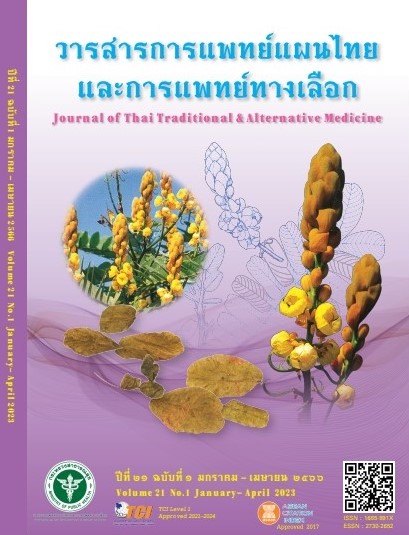Comparison of Male and Female Rock Salt Properties Using the Principles of Hot Salt Pot Compression (Tub Mor Kluea)
Main Article Content
Abstract
Hot salt pot compression (Tub Mor Kluea) for postpartum women is performed by placing male rock salt in a clay pot, or mor thanan, for heat retention purposes. According to the textbooks on Thai traditional medicine (TTM), there are two types of rock salt: male and female. However, there has not been any report that clearly states that why it needs to use only male rock salt for such a compression. Additionally, some text books are not even specific about the gender of the salt. The objectives of this research were (1) to study the heat retention properties of male rock salt and female rock salt and (2) to compare the thermal storage properties of male rock salt and female rock salt. Research method: (1) measure size and weight of six small round clay pots to make sure that they were about the same size and weight; (2) measure the size and weight of each grain of male and female rock salt, before and after the experiment, to determine the changes in size and weight; (3) determine the heat retention capacity of both types of salt by placing a certain amount of male rock salt in three pots and female rock salt in the other three pots; the salt density in each pot should be 0.8 g/cm3; (4) set the electric stove until the heat reaches 300 ˚C for 5 minutes; then place the salt pot on the stove and set the timer until the salt is cooked; (5) lift the salt pot off the stove and place it on top of the prepared herbs and immediately wrap it with the cloth; let it cool down to room temperature; (6) take and record the temperature of the cooked salt and the time it takes for the salt to be cooked; and take the temperature of salt in the pot upon cloth-wrapping completion until cooling down to room temperature during the experiment; (7) take the salt pot to repeat and finish five cycles of steps 4 through 6. The results of the experiment showed that the sizes and volumes of male and female rock salt grains decreased after the heating. The boiling temperature of male rock salt was higher than that for female rock salt. In the five cycles of experiment, the average cooking temperatures for male and female rock salts were 106.49 ± 2.76 ˚C and 61.42 ± 4.49 ˚C, respectively. The time required to reach the cooking point for both male and female rock salts in cycles 1–5 increased. As for heat retention, male rock salt retains the heat better than female rock salt; the ability to retain heat in each of cycles 1–5 declined for both types of rock salt. In summary, male rock salt has better heat retention properties than female rock salt, which is in line with related statement in the TTM textbook: “Male rock salt should be used for hot salt pot compression and use it only once.”
Article Details

This work is licensed under a Creative Commons Attribution-NonCommercial-NoDerivatives 4.0 International License.
References
Office of Academic Affairs, Department of Thai Traditional and Alternative Medicine, Ministry of Public Health. Thai public health report in Thai traditional medicine, folk medicine and alternative medicine 1. Bangkok: The Veterans Welfare Organization’s printing house activities office; 2010. 451 p. (in Thai)
Jamjan L, Khantarakwong S, Hongthong S, Jampates N. Thai traditional medicine for postnatal motherin the community of Central region. Journal of The Royal Thai Army Nurses. 2014;15(2):195-202. (in Thai)
Pumtong S, Wirasathien L, Sitthithaworn W, Rungmekarat A, Paeratakul O. Postpartum care through traditional Thai medicine in Amnat Charoen province. Journal of Health Systems Research. 2010;4(2):281-95. (in Thai)
Namanee A. The enhancement of the mother and children’s health care: the perspectives from the Thai medication and the modern medication. Thammasat Medical Journal. 2013;13(1):79-88. (in Thai)
Navadach N, Inman W, Singkhamphong N, Boonrasri S, Noipha K. Postnatal mothers’ satisfaction toward postpartum care project using Thai traditional medicine of Ranod Hospital, Songkhla province. RMUTSV Research Journal. 2020;12(3):483-94. (in Thai)
Suwannapruek R. General chemistry volume 1.3. Bangkok: Wittayapat; 2016. 584 p. (in Thai)


